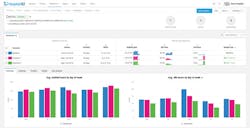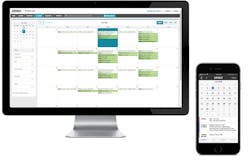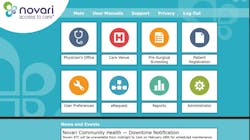When Healthcare Purchasing News hosted its first annual OR Leadership Summit in January — a fruitful and evocative event that gave operating room directors from across the country an opportunity to meet, share and learn from each other — many similarities were revealed. For instance, when asked “What keeps you up at night?” an overwhelming majority of attendees said one of their biggest worries is not having enough skilled clinicians to handle case volume. Not only is it a widespread problem but many seem to feel that it’s going to get worse over time.
“Unfortunately, lack of skilled staff continues to be an issue in almost every perioperative department in the country,” said Erin Kyle, DNP, RN, CNOR, NEA-BC, Perioperative Practice Specialist, Association of periOperative Registered Nurses (AORN). “According to the 2018 AORN salary survey, 30.8 percent of respondents reported less than five years nursing experience which is an increase of 1.5 percent over the 2017 salary survey results. With increasing complexity in surgical procedures and equipment, this lesser degree of nursing experience can lead to errors and risks related to inexperience among staff.”
Inexperienced staff, lack of staff — whatever the staffing issue is — organizations feeling the pressure need to incorporate non-human fixes to survive, which means focusing on areas where improvements can be made more readily to make clinical teams organized, motivated and productive on every case. Implementing one of today’s scheduling software solutions is one way to make everyone’s job easier.
“Effective scheduling systems are vital to efficient perioperative service delivery,” Kyle said. “While surgeon and procedure-specific preference lists are the ‘recipes’ for case planning, scheduling systems are the selectors of these preference lists. One way that ineffective scheduling systems may contribute to the problem that keeps OR managers up at night may be that unreliable systems can result in ambiguity about what will be needed on the day of surgery. If more staff members are needed than are available, it poses a debilitating issue for OR managers with little time to make staffing adjustments on the day of surgery.”
Arrested performance
To continue using an outdated scheduling system in an already challenging situation, or one with features that do not adequately support the OR’s current needs can snowball very quickly into a much bigger problem.
“In 2019, many hospital surgical booking requests continued to be received by fax, paper and even telephone calls. These processes are very inefficient and expose both the hospital, its staff and patients to unnecessary risk,” said John Sinclair, CPHIMS, President, Novari Health. “Hand delivered or faxed paper booking forms are often incomplete, illegible or include cryptic abbreviations creating additional costly follow up for hospital staff. Fax and paper may be misplaced, picked up by someone else or worse, not even be received. Fax, paper and phone calls with OR scheduling requests from the surgeons or their offices do not calculate, track or inform the surgeon of her OR block utilization with each booking. All around it’s not a safe or efficient process.”
More specifically, Kyle said, “some of the most common complaints from OR staff are around errors in scheduling, including wrong procedure, wrong approach (e.g., laparoscopic v. robotic), wrong laterality, communication about specialty needs not complete (e.g., specialty instrumentation not ordered in time for sterilization to appropriately occur), computer-generated time required for case is incorrect, and the correct procedure- and surgeon- preference list is not attached to the scheduled case.
“These problems really represent an interaction of human factors and computer interface errors,” she continued. “Computer systems should, in a perfect world, support humans who use them by protecting them from errors arising from human factors. In reality, however, this is frequently not the case. A compounding issue is that some systems do not support workflows and some personnel who schedule surgical procedures find workarounds in ineffective systems.”
Justin Rockman, VP of Sales and Business Development, Surgimate, explains further, noting how important interoperability is achieved only when the right tools are in place. “Practices are using a patchwork of systems to schedule surgery; since the systems don’t communicate with each other through proper integrations, there is enormous inefficiency and duplication of work,” Rockman said. “Paperwork will fall between the cracks, causing surgeries to be unnecessarily canceled. This has a tremendous impact on revenue, patient care and surgeon burnout. The most common complaint we hear is that surgeries are canceled unnecessarily. This can be caused by a clearance not being received or insurance not authorizing surgery or equipment required not being ordered. Ensuring that a surgery is prepared properly is a very difficult task as there as so many balls in the air.
“Another common complaint we hear from practices is that they are missing out on surgical reimbursements,” continued Rockman. “This can often happen because surgeons are not efficiently giving in their codes to billers or when they do, they are incomplete. Notes and codes from the surgeon are not passed directly to billing immediately after surgery. Bringing on a surgical charge capture system can help reduce this issue and generate more revenue for the practice.”
Jason Harber, Senior Vice President, Product Management, Hospital IQ, says block utilization, emergent cases and cancelations are factors that demand smart scheduling programs. “It is in these areas that scheduling systems contribute to staffing difficulties as they do not provide managers the visibility to these changes and an ability to make changes in real-time,” he said. “In addition, these systems do not consider real historical demand and past performance which should be a requisite data element for an informed staffing pattern and subsequent staffing decisions.
“It’s also important to consider that IT systems can either reinforce existing behaviors or be used as a tool to enforce better behaviors,” Harber continued. “A lot of staffing difficulties existed before the staffing system was implemented and hospitals are using the systems to automate their previous, inefficient methods. This really becomes a change management issue that hospitals face when adopting new technology; they need to reevaluate and redefine the overall process approach in alignment with the best use of the technology.”
Jeff Robbins, President, CEO, Founder, LiveData, Inc., holds a similar view on what makes some scheduling systems more of a problem than a solution. “Most scheduling systems lack the ability to accurately track surgical block usage and how effectively the block time is used by service or clinicians,” he asserted. “Without data, surgery schedules cannot be developed to achieve optimum utilization of available resources. Surgical scheduling systems need to capture actual utilization data to support analyzing how efficient blocks are used down to the level of specific OR, service, procedure performed, and clinician or operating team.
“With detailed operational data available, surgery planners can view rooms and resources, patients needing surgery, and consistently build schedules to handle case volume,” Robbins continued. “Scheduling systems and scheduling staff need to integrate patient-specific workup checklists and patient outreach into scheduling workflow within the surgical facility to synchronize surgical preparation with day of surgery-patient arrivals. Dynamic scheduling to re-assign operating rooms and surgical teams as schedules change during the day and the ability to display and communicate patient progress or workflow to surgical teams throughout the day will enable changes on-the-fly to eliminate or reduce unused block time.”
Triumph with tech
Now that we’ve covered the myriad things that could go wrong when using an obsolete scheduling system, here’s a look at some technologies that aim to make things right.
These newer technologies do much more than connect Mr. Jones with Dr. Smith and her team for a knee replacement on Wednesday morning at 7:30. Many contemporary scheduling systems help to also streamline clinical processes and reduce inefficiencies, prevent errors, populate EHRs, capture charges, reduce burnout and save hospitals and other surgical centers some serious dough.
“Many integrated electronic medical records come with scheduling technology,” said Kyle. “Scheduling systems that are already integrated with an organization-wide platform may carry fewer interface problems than add-on scheduling systems. If an OR manager is seeking to upgrade, here are some words of advice:
Enlist the assistance of an interdisciplinary team first and as early as you can in the planning phase:
- Surgeon representative
- IT department representative
- Finance/charge capture team representative
- Perioperative clinical team representative
- Nurse informaticist
- EMR representative
- Scheduling personnel
- Senior leadership
Be sure to talk with other users of the system before committing to a change.
Complete a comprehensive trial of the system before purchase if possible.
Carefully compare features of competing systems and choose the one that most closely fits your organization’s unique needs. A large academic center with multiple campuses will have very different needs than a small ambulatory surgery center.”
“The Hospital IQ operations planning and management software platform is designed to help hospitals effectively manage and optimize resource utilization, patient wait times, staff workload, and the satisfaction of everyone involved across all areas of the hospital,” said Harber. “The platform transforms data from your traditional IT systems into actionable information for your organization. The combination of data, analytics engine, and algorithms provide a powerful toolkit to drive decision-making for both short-term improvements and long-term strategic planning. Specifically, Hospital IQ for Perioperative helps health systems improve how the perioperative suite functions: It is a data-driven system that applies system-specific policies, machine learning and optimization algorithms to hospital perioperative data to accurately forecast OR usage and make recommendations that will improve block, OR, and staff utilization, as well as grow volume. From a staff scheduling perspective, Hospital IQ for Perioperative enables the following:
Staffing grid recommendations: Build a long-term shift strategy
Hospital IQ for Perioperative gives you the ability to construct different scenarios for testing staffing grid schedules and assessing their impact on total costs, surgical volume, and staff satisfaction. By applying such data as labor policies, staffing practices, credentials and roles as well as historical and forecasted surgical volume and mix, Hospital IQ for Perioperative will provide optimized staffing grids for specific service lines and the entire perioperative suite.
Staffing gap identification: identify and correct staffing misalignments.
Hospital IQ for Perioperative also recommends changes in staffing levels as the surgical schedule picture emerges. Using advanced forecasting technology, the system can predict increases or decreases in volume as the surgical day approaches, identifying potential overstaffing- and understaffing situations in advance. This allows staffing managers to adjust staffing proactively — days before a labor crisis develops.”
“LiveData PeriOp Manager is a fully integrated, real-time perioperative system of engagement that coordinates and manages the patient’s journey through surgery,” said Robbins. “This provides unprecedented operational intelligence enabling hospitals and Ambulatory Surgical Centers to plan, coordinate, and analyze surgical workflows. Scheduling modules include:
- LiveData PeriOp Planner interactive tools to build and track individual patient preoperative workups and synchronize operating room schedules and resources to avoid last minute cancellations and optimize the use of operating room time.
- OR-Schedule Board —a dynamic, real-time view of the day’s surgical caseload. It automatically adjusts case start and end times based on real-time case workflow monitoring and provides interactive tools to manage OR assignment and clinical staffing on the fly.
- PeriOp Manager Analytics delivers comprehensive data analytics transforming real-time operational data into actionable quality, compliance, and efficiency intelligence. Data is captured directly from clinical and operational systems so performance information can be analyzed within hours versus weeks enabling immediate performance improvements.
LiveData customers have measured reduced surgical case cancellations, increased on-time starts and block utilization, and improved case scheduling accuracy.”
“Surgimate Practice is an advanced cloud-based surgical coordination platform for surgical practices,” said Rockman, noting such features as:
- A robust surgical calendar uniquely designed to manage the complexity of surgical scheduling — such as managing block time and on-calls.
- It integrates directly with most practice management systems and EHRs to ensure there is no duplicate data entry.
- It incorporates the surgeon’s unique preferences using custom templates so everyone knows which equipment, resources tools are needed for each surgery. This is then seamlessly communicated to the OR, so less time and resources are wasted by both scheduling and clinical staff at the OR.
- Scheduler and managers can track all outstanding tasks by case using a digital checklist. From one dashboard you can say which of your upcoming surgeries need clearances, equipment ordered, pre-certification etc. This is the best way to ensure nothing slips through the cracks and avoids last minute scrabbling or worse, unnecessary cancellations and delays for the patients.
- Surgimate has a fantastic mobile app which allows surgeons and PAs to securely see their schedules on their phones. Using the app staff can submit surgical charges including procedure, diagnosis and modifier codes directly from the OR thereby increasing reimbursement rates.
“We have made it a top priority to ensure there is interoperability with EHRs and PMs either through an API or HL7 messaging,” said Rockman. “A platform like ours brings together many of the tools that practices use to schedule surgeries in a more streamlined way.”
“Novari Health’s ATC eBooking software solution streamlines the booking process for surgical and other hospital programs by allowing the surgeons offices to electronically submit their surgery bookings to your existing OR scheduling system (including any supporting documentation),” said Sinclair. For example:
- Booking requests from the surgeons’ office are transmitted electronically via interface to your existing OR scheduling system for the surgical scheduler to view, manage and schedule electronically, without the need to transcribe or manually enter the information.
- The software is easy to use and improves the scheduling offices’ ability to manage incoming bookings while providing perioperative leadership with tools to better understand the volume of cases in the pipeline.
- It allows the surgeons to see their blocks and their scheduled utilization in real time from their own office. By allowing surgeons to see their blocks and scheduled utilization in real time, they intuitively will schedule more cases and increase utilization.
Using Novari’s web based eBooking technology to integrate the physician offices with the hospital scheduling systems improves patient safety, increases OR utilization and physician satisfaction while improving the surgical program’s bottom line.”
See Sidebar: Overturn your room turnover rationale

Valerie J. Dimond | Managing Editor
Valerie J. Dimond was previously Managing Editor of Healthcare Purchasing News.










